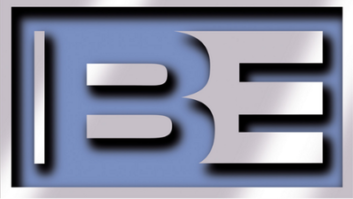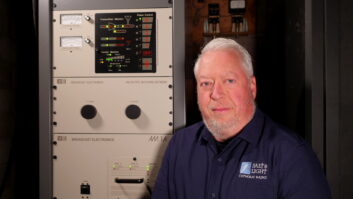I met Gary Ellingson at this year’s NAB Show in Las Vegas. He’s the chief engineer for Northwestern College and Radio, KFNW(AM/FM) in Fargo, N.D., and KNWC(AM/FM) in Sioux Falls, S.D.
Gary told me about his RFI interference issues and how they have been mitigated with products from Nott Ltd. and ferrite suppressors from Newark Electronics.
(click thumbnail)Fig. 1: Nott Ltd’s Ferrolinear RF chokes Gary has Nott Ferrolinear RF chokes installed on the power line poles surrounding the KFNW array. There’s an interesting tutorial on static and ground lines on wooden power poles at www.nottltd.com/FerrolinearRFChoke.pdf.
There’s also a procedure to see if the wooden poles are affecting your AM array.
The clamshell toroids in Fig. 2 were used inside and are a remarkably inexpensive way to control interference in a high RF field.
Made by Fair-Rite, their part number is 16F002. It is a round cable snap-on suppressor with an inner diameter of 0.21 inches. The 73K6078 is a little larger, with an inside diameter of 0.275 inches. The 50B335 has an inner diameter of 0.525 inches.
All three suppressors are less than $3 each and can be found in the Newark catalog at www.newark.com.
* * *
(click thumbnail)Fig. 2: Clamshell style ferrite toroids slip over cables to reduce RFI
Lawrence Behr is CEO of LBA Group Inc. in Greenville, N.C. (www.lbagroup.com).
He commented on two recent Workbench topics, both in the April 23 column: mouse contamination and the spark gap shield.
With regard to cleaning up after rodents, chlorine substances may be a winner from a sanitation standpoint, but it’s a potential disaster equipment-wise, he says. Chlorine substances are corrosive to aluminum and copper and will wreck electronics.
As readers may know, smoke from PVC ruins all it touches; the same is true for Clorox, and you can’t clean it up. Even using it on the floor near the air intake for a transmitter can cause corrosion problems.
Inside an enclosed antenna tuning unit, the resultant fumes can take their toll on copper coils and strap. Lawrence’s advice is to check the ingredients of any cleaning compound you intend to use, to prevent these headaches.
With regard to Harry Bingaman’s funnel spark gap shield, Lawrence agrees that the funnel will work. The problem is that the tower is fitted with a vertical spark gap in the first place. Much better would be the installation of new offset gaps.
While the funnel solution doesn’t matter much at low power, this arrangement at high power could do a lot of damage.
Station engineers should insist that tower erectors not install the vertical spark gap, which is all too common because it is cheap — a good point to consider if you’re specifying a new AM tower.
* * *
Speaking of funnels, contract and projects engineer Gary Saber in Raleigh, N.C. observes that an open funnel could entice wasps or bees to build a nest inside.
Gary suggests adding a fiberglass insect screen over the opening of the funnel and sealing the top opening with RTV to help prevent insect nesting.
Also, a funnel made of black plastic should last longer because it will not deteriorate from UV exposure.
* * *
Cary, N.C., is a stone’s throw from Raleigh, and Chuk Gleason calls it home.
Chuk does mostly two-way work now. He keeps up with Radio World online, and writes that he was intrigued by the idea of hiding cabling and ground strap behind plywood panels under AM ATUs (Workbench, April 23).
Chuk offers a slightly more advanced suggestion.
Instead of mounting painted plywood panels, how about using sheets of plastic — polyurethane, for example? The heavy plastic sheets that are used to cover walls in restrooms might last longer.
Plywood, Chuk adds, no matter how well you seal it, eventually will weather and delaminate. He suggests a visit to a plastics distributor to see what’s available.
Chuk admits that cost may be an issue. Four panels of half-inch sheet plastic may seriously impact your budget!
* * *
Mike Babbitt is the customer support manager for Dolby Laboratories. He wants Workbench readers to know of the launch of the online Dolby Forums, for the use of professionals who have registered an account at www.dolbysupport.com.
After logging into the site, you’ll notice a blue “User Forums” button on the left side of the page. Clicking here will open a new Dolby Support Internet presence in your browser that will allow you to ask and answer questions, post application ideas and communicate and share ideas with fellow users of Dolby products and technologies as well as Dolby specialists.
* * *
(click thumbnail)Fig. 3: Paul Sagi in Kuala Lumpur says the EZ Hang can shoot a line 100 feet or more.
Paul Sagi in Kuala Lumpur always has an interesting tip or two.
Reading about ways to run wires, he suggests visiting www.ezhang.com. The patented EZ Hang can shoot a line 100 feet or more.
It’s a combination slingshot and fishing reel that comes with 300 feet of 10-pound-test monofilament line, a quick disconnect clip to release the weight, and an easy-to-see bright yellow one-ounce lead weight.
Used by hams to string antennas from trees, it may be of help in plenty of other applications.
Paul adds that when he was using fish tapes inside a wall or ceiling, he needed a way of knowing when the tapes touched.
Since he was working blind — the entry and exit holes were small — he could not see the two ends. Connecting both tapes to a low voltage DC source and a buzzer gave him an audible indication of when the tapes touched. Knowing this made hooking them together easier.














